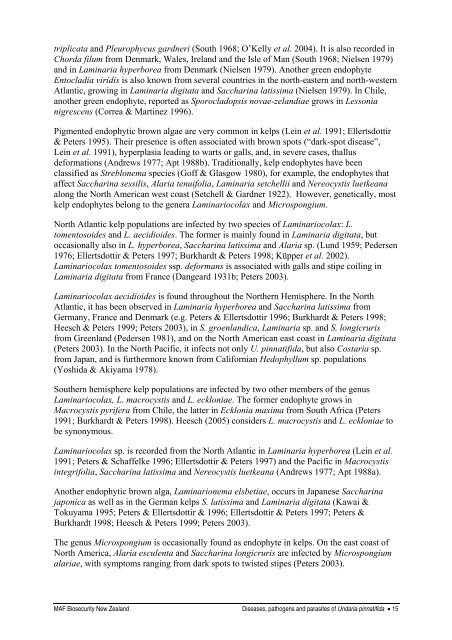Diseases, pathogens and parasites of Undaria pinnatifida
Diseases, pathogens and parasites of Undaria pinnatifida
Diseases, pathogens and parasites of Undaria pinnatifida
Create successful ePaper yourself
Turn your PDF publications into a flip-book with our unique Google optimized e-Paper software.
triplicata <strong>and</strong> Pleurophycus gardneri (South 1968; O’Kelly et al. 2004). It is also recorded in<br />
Chorda filum from Denmark, Wales, Irel<strong>and</strong> <strong>and</strong> the Isle <strong>of</strong> Man (South 1968; Nielsen 1979)<br />
<strong>and</strong> in Laminaria hyperborea from Denmark (Nielsen 1979). Another green endophyte<br />
Entocladia viridis is also known from several countries in the north-eastern <strong>and</strong> north-western<br />
Atlantic, growing in Laminaria digitata <strong>and</strong> Saccharina latissima (Nielsen 1979). In Chile,<br />
another green endophyte, reported as Sporocladopsis novae-zel<strong>and</strong>iae grows in Lessonia<br />
nigrescens (Correa & Martinez 1996).<br />
Pigmented endophytic brown algae are very common in kelps (Lein et al. 1991; Ellertsdottir<br />
& Peters 1995). Their presence is <strong>of</strong>ten associated with brown spots (“dark-spot disease”,<br />
Lein et al. 1991), hyperplasia leading to warts or galls, <strong>and</strong>, in severe cases, thallus<br />
deformations (Andrews 1977; Apt 1988b). Traditionally, kelp endophytes have been<br />
classified as Streblonema species (G<strong>of</strong>f & Glasgow 1980), for example, the endophytes that<br />
affect Saccharina sessilis, Alaria tenuifolia, Laminaria setchellii <strong>and</strong> Nereocystis luetkeana<br />
along the North American west coast (Setchell & Gardner 1922). However, genetically, most<br />
kelp endophytes belong to the genera Laminariocolax <strong>and</strong> Microspongium.<br />
North Atlantic kelp populations are infected by two species <strong>of</strong> Laminariocolax: L.<br />
tomentosoides <strong>and</strong> L. aecidioides. The former is mainly found in Laminaria digitata, but<br />
occasionally also in L. hyperborea, Saccharina latissima <strong>and</strong> Alaria sp. (Lund 1959; Pedersen<br />
1976; Ellertsdottir & Peters 1997; Burkhardt & Peters 1998; Küpper et al. 2002).<br />
Laminariocolax tomentosoides ssp. deformans is associated with galls <strong>and</strong> stipe coiling in<br />
Laminaria digitata from France (Dangeard 1931b; Peters 2003).<br />
Laminariocolax aecidioides is found throughout the Northern Hemisphere. In the North<br />
Atlantic, it has been observed in Laminaria hyperborea <strong>and</strong> Saccharina latissima from<br />
Germany, France <strong>and</strong> Denmark (e.g. Peters & Ellertsdottir 1996; Burkhardt & Peters 1998;<br />
Heesch & Peters 1999; Peters 2003), in S. groenl<strong>and</strong>ica, Laminaria sp. <strong>and</strong> S. longicruris<br />
from Greenl<strong>and</strong> (Pedersen 1981), <strong>and</strong> on the North American east coast in Laminaria digitata<br />
(Peters 2003). In the North Pacific, it infects not only U. <strong>pinnatifida</strong>, but also Costaria sp.<br />
from Japan, <strong>and</strong> is furthermore known from Californian Hedophyllum sp. populations<br />
(Yoshida & Akiyama 1978).<br />
Southern hemisphere kelp populations are infected by two other members <strong>of</strong> the genus<br />
Laminariocolax, L. macrocystis <strong>and</strong> L. eckloniae. The former endophyte grows in<br />
Macrocystis pyrifera from Chile, the latter in Ecklonia maxima from South Africa (Peters<br />
1991; Burkhardt & Peters 1998). Heesch (2005) considers L. macrocystis <strong>and</strong> L. eckloniae to<br />
be synonymous.<br />
Laminariocolax sp. is recorded from the North Atlantic in Laminaria hyperborea (Lein et al.<br />
1991; Peters & Schaffelke 1996; Ellertsdottir & Peters 1997) <strong>and</strong> the Pacific in Macrocystis<br />
integrifolia, Saccharina latissima <strong>and</strong> Nereocystis luetkeana (Andrews 1977; Apt 1988a).<br />
Another endophytic brown alga, Laminarionema elsbetiae, occurs in Japanese Saccharina<br />
japonica as well as in the German kelps S. latissima <strong>and</strong> Laminaria digitata (Kawai &<br />
Tokuyama 1995; Peters & Ellertsdottir & 1996; Ellertsdottir & Peters 1997; Peters &<br />
Burkhardt 1998; Heesch & Peters 1999; Peters 2003).<br />
The genus Microspongium is occasionally found as endophyte in kelps. On the east coast <strong>of</strong><br />
North America, Alaria esculenta <strong>and</strong> Saccharina longicruris are infected by Microspongium<br />
alariae, with symptoms ranging from dark spots to twisted stipes (Peters 2003).<br />
MAF Biosecurity New Zeal<strong>and</strong> <strong>Diseases</strong>, <strong>pathogens</strong> <strong>and</strong> <strong>parasites</strong> <strong>of</strong> <strong>Undaria</strong> <strong>pinnatifida</strong> • 15

















